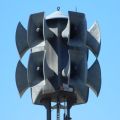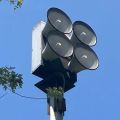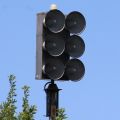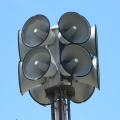EOWS
| SiraTone
Electronic Outdoor Warning Siren (EOWS) | |
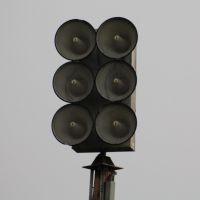 A SiraTone Model EOWS*612 in Wynnewood, OK. Photo taken by Valra Bellkeys | |
| Company | Federal Signal |
|---|---|
| Produced | 1981-2007 |
| Type | Rotational Electronic
Omnidirectional Electronic
|
| Sound output | 113-124 dB @ 100 ft |
| Wattage | 800-1200 W |
| Voltage | 24 V DC |
| Succeeded by | |
| Documentation | Manual Product sheet |
SiraTone, also known as the EOWS (Electronic Outdoor Warning Siren)[1] was a line of electronic sirens that were produced by Federal Signal over a span of 20 years, coming in both omnidirectional and rotational models. It was Federal Signal's first attempt at making an electronic siren, and while they had some teething issues, the series proved to be a very popular option, competing with Whelen Engineering's WS-2000, WS-3000, and WPS-4000 sirens, and later Alerting Communicators of America (ACA)'s Alertronic sirens.
History
The EOWS came to light in 1980 when Federal Signal won a bid for an electronic siren system to be installed at the William H. Zimmer Power Station. Federal Signal however did not have an electronic siren line, so this led to a new development they called SiraTone. Federal Signal produced around 30 Model EOWS*115 sirens for the plant system in 1981. The original EOWS*115 sirens were later absorbed into surrounding communities after the Zimmer nuclear plant fell through. A few Zimmer units can be found today still in service; however, most are on newer controllers.
After Federal Signal created this new product, they tweaked the SiraTone controller and expanded upon their electronic line with the introduction of the Models EOWS*408, EOWS*812, and EOWS*M12. The EOWS*408 and EOWS*812 were rotating beam sirens made for better sound concentration and projection, while the EOWS*M12 was a mobile public notification system intended for short-range notification, to be mounted to the roof of a police car or van at large events. Despite these new additions, the EOWS*115 was still available as the only omnidirectional model they offered. For the new rotating arrays, Federal Signal chose a simple design similar to rotating signs and partnered with Dynapac Rotating Company as their supplier for their rotation mechanisms. These arrays featured a Dynapac Model K-25 rotator with a quad-brush collector ring assembly allowing the arrays to rotate a full 360° stall-free, requiring little to no maintenance. Likewise, Federal Signal also partnered up with University Sound (an Altec Lansing company) as the supplier for the 26" spun aluminum horns used for the EOWS*408 and EOWS*812.

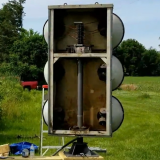
In early stages, the EOWS*812 and EOWS*408 were made in a more compact manner with the speaker horns recessed into the housing attached to the rear frame. This was very short lived likely due to manufacturing troubles, and was ditched by 1983, with the horns being mounted directly to the frame wall.
Towards the end of 1984, Federal Signal introduced 2 new EOWS products, the EOWS*1212 and EOWS*612. The EOWS*1212 was simply an EOWS*115 with round University Sound aluminum horns replacing the original rectangular Atlas fiberglass horns. This was done for a small boost in performance thanks to better sound propagation with the aluminum horns, while also unifying the product line with the existing models.
The EOWS*612 was a combination of the 408 and 812; its performance matched the EOWS*812 while staying relatively compact like the EOWS*408. It also used less materials than the EOWS*812, making it much more economical and easier to handle/manage. With the introduction of the EOWS*612 came the discontinuation of the EOWS*812 and EOWS*408 due to both being made obsolete. However, the EOWS*115 stuck around as a cheaper base siren with reduced performance. It is unclear when the EOWS*M12 was discontinued.
Federal Signal continued production of the EOWS*1212, EOWS*115 and EOWS*612 for a few years; the EOWS*115 was eliminated from the product line sometime in 1988. Federal Signal created a new line of electronic sirens named the Modulator in 1990 which offered true omnidirectional coverage, leading to the demise of the EOWS*1212 the same year. However, Federal Signal kept the EOWS*612 in production as it was an efficient and powerful rotating electronic siren—the only rotating electronic siren offering Federal Signal had at that time—and was still in high demand. Federal Signal kept the EOWS*612 up to date, modernizing it with their latest MC controller at the time and later the newer MCP and UltraVoice (UV). The EOWS*612 stuck around for many years, although Federal Signal removed it from their public websites in 2001 and only offered it as a special-order model from 2001 to 2007. Altec Lansing's financial troubles resulted in the discontinuation of their University Sound branch, leaving Federal with no source for speakers; as such, the EOWS*612 was discontinued in 2007 and the last EOWS*612 was sold on August 3rd of that year.
All SiraTone sirens are fairly simplistic electronic sirens and are easy to update with modern hardware. Many units still in service are on the latest UltraVoice controller from Federal Signal. Many are on older Federal controllers, like the MC and MCP. Some units are even on third party controllers from brands such as American Signal Corporation or Whelen Engineering. SiraTone sirens were originally manufactured with simple common components, meaning they were easy to repair if needed. Any SiraTone is fully compatible with the UV; the UltraVoice controller openly states its compatibility with the EOWS*612 in its documentation and earlier documentation stated its compatibility with the EOWS*1212 as well. Because of their compatibility, SiraTone sirens can be kept in service long after their original controllers begin to fail; despite many newer electronic sirens being available, some municipalities have chosen to keep and maintain their old SiraTone systems. Today, these sirens are somewhat uncommon due to their age but can still be found across North America though their numbers are dwindling.
Design
Model EOWS*115
The Model EOWS*115 uses a tall hexagonal fiberglass housing containing 12 100 W speaker drivers, as well as the wiring. A small rain shield on top helps protect the electronics. The siren uses 12 rectangular fiberglass Atlas Sound Model CJ-44 horns which are not very efficient at projecting sound; because of this, the EOWS*115 is the quietest of any SiraTone siren, rated only 113 dB at 100 ft. Mainline EOWS*115 sirens are almost identical to the early William H. Zimmer Power Station models, with the only difference being the improved SiraTone controller which fixed many of the issues the Zimmer units had.
Model EOWS*408
The Model EOWS*408 uses 4 University Sound Model DR-42 aluminum speakers and 8 100 W speaker drivers with 2 drivers per horn. A square enclosure behind the horns protects the electronics and is attached to a Dynapac Model K-25 rotator at the base with collector rings that allow the entire siren unit to rotate 360°. Originally, the speakers were recessed into the enclosure, but due to manufacturing troubles the speakers were changed to be bolted directly onto the housing in 1983. The siren could be equipped with a strobe light above the enclosure for visual notification on request. The EOWS*408 is rated 119 dB at 100 ft.
Model EOWS*812
The Model EOWS*812 uses 8 University Sound Model DR-42 aluminum speakers and 12 100 W speaker drivers; the 4 speakers in the middle of the siren have 2 100 W drivers each, while the top and bottom rows of horns have 1 100 W speaker driver per horn. A square enclosure behind the horns protects the electronics and is attached to a Dynapac Model K-25 rotator at the base with collector rings that allow the entire siren unit to rotate 360°. Originally, the speakers were recessed into the enclosure, but due to manufacturing troubles the speakers were changed to be bolted directly onto the housing in 1983. The siren could be equipped with a strobe light above the enclosure for visual notification on request. The EOWS*812 is rated 124 dB at 100 ft.
Model EOWS*M12

The Model EOWS*M12 uses 4 Atlas CJ-44 horns and 4 speaker drivers; 2 of each horn assembly is attached to 1 side of a small rectangular enclosure. These are quite large and are depicted as nearly the size of the roof of a car in Federal Signal literature. The EOWS*M12 is rated 123 dB at 10 ft. Little is known about this siren or the controller it used.
Model EOWS*1212
The Model EOWS*1212 uses a tall hexagonal fiberglass housing containing 12 100 W speaker drivers, as well as the wiring. A small rain shield on top helps protect the electronics. The siren uses 12 University Sound Model DR-42 aluminum speakers which offered better performance than the Atlas speakers; because of this, the EOWS*1212 offered better performance, reaching 115 dB at 100 ft.
Model EOWS*612
The Model EOWS*612 uses 6 University Sound Model DR-42 aluminum speakers and 12 100 W speaker drivers with 2 drivers per horn. A square enclosure behind the horns protects the electronics and is attached to a Dynapac Model K-25 rotator at the base with collector rings that allow the entire siren unit to rotate 360°. The siren could be equipped with a strobe light above the enclosure for visual notification on request. The EOWS*612 is rated 124 dB at 100 ft.
Gallery
Pictures
-
A Model EOWS*115 in Slippery Rock, PA. Photo taken by Christopher J. (TrainsAndSirens1)
-
A Model EOWS*408 in Herrin, IL. Photo taken by duxing612.
-
A Model EOWS*612 with a strobe light equipped, located in Tulsa, OK. Photo taken by Valra Bellkeys.
-
A Model EOWS*812 in Bay City, MI.
-
A Model EOWS*1212 in Lockhart, SC. Photo taken by Christopher J. (TrainsAndSirens1)
Diagrams
-
A diagram of a Model EOWS*115.
-
A diagram of a Model EOWS*408.
-
A diagram of a Model EOWS*612.
-
A diagram of a Model EOWS*812.
-
A diagram of a Model EOWS*1212.
Examples
 A Federal Signal EOWS*812 sounding in the “Steady” tone in Harvey County, Kansas.
A Federal Signal EOWS*812 sounding in the “Steady” tone in Harvey County, Kansas. A Federal Signal EOWS*115 sounding a short alert in Rapid City, South Dakota
A Federal Signal EOWS*115 sounding a short alert in Rapid City, South Dakota
- ↑ (Electronic Outdoor Warning Siren)
